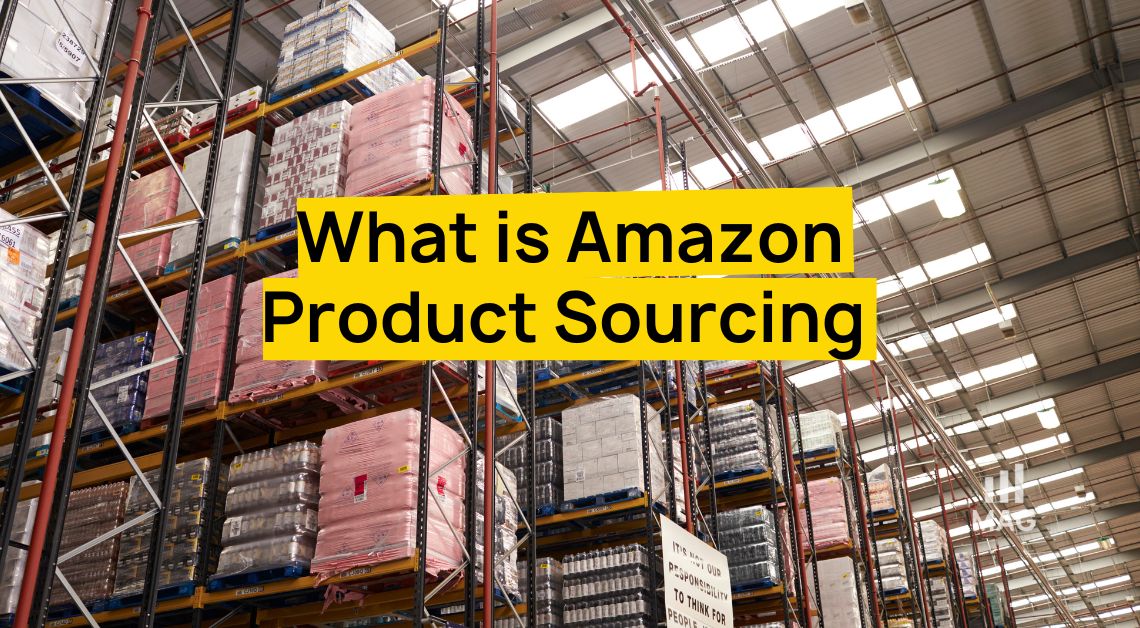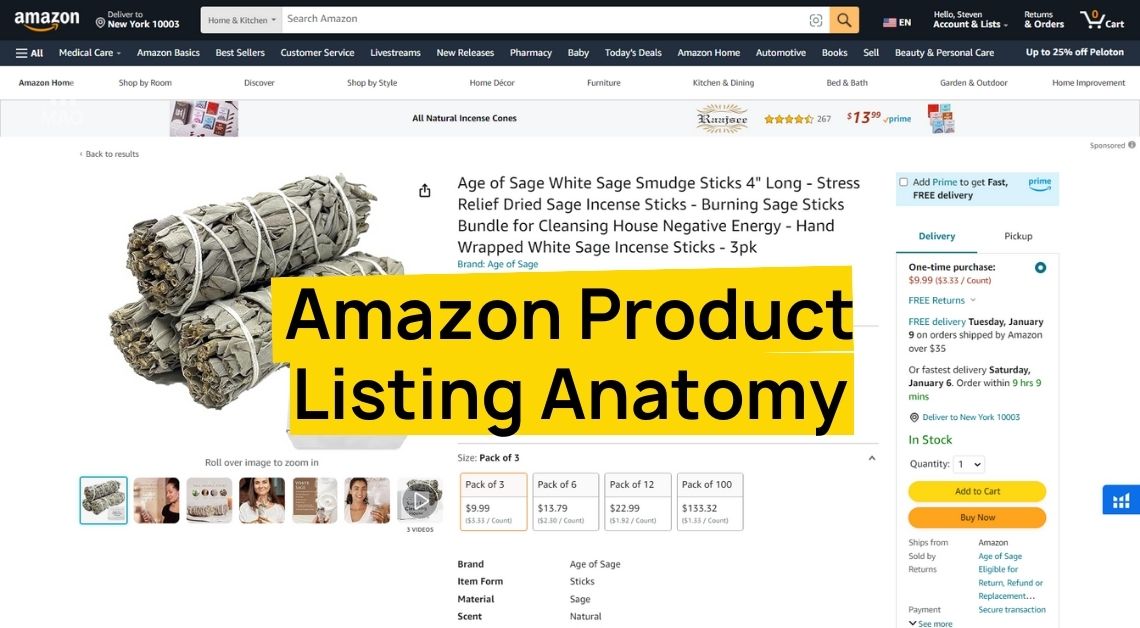Amazon product research is the key to success on Amazon. By finding products that are in high demand, have low competition, and are easy to source, you can increase your chances of making a profit.
In this blog post, we will discuss the importance of Amazon product research and provide some tips on how to do it effectively. We will also cover some of the best tools available to help you with your research.
So whether you are a new Amazon seller or you are looking to improve your existing business, read on to learn more about Amazon product research and how it can help you succeed.
How Important Is Amazon Product Research To Sellers
What Is The Objective of Amazon Product Research?
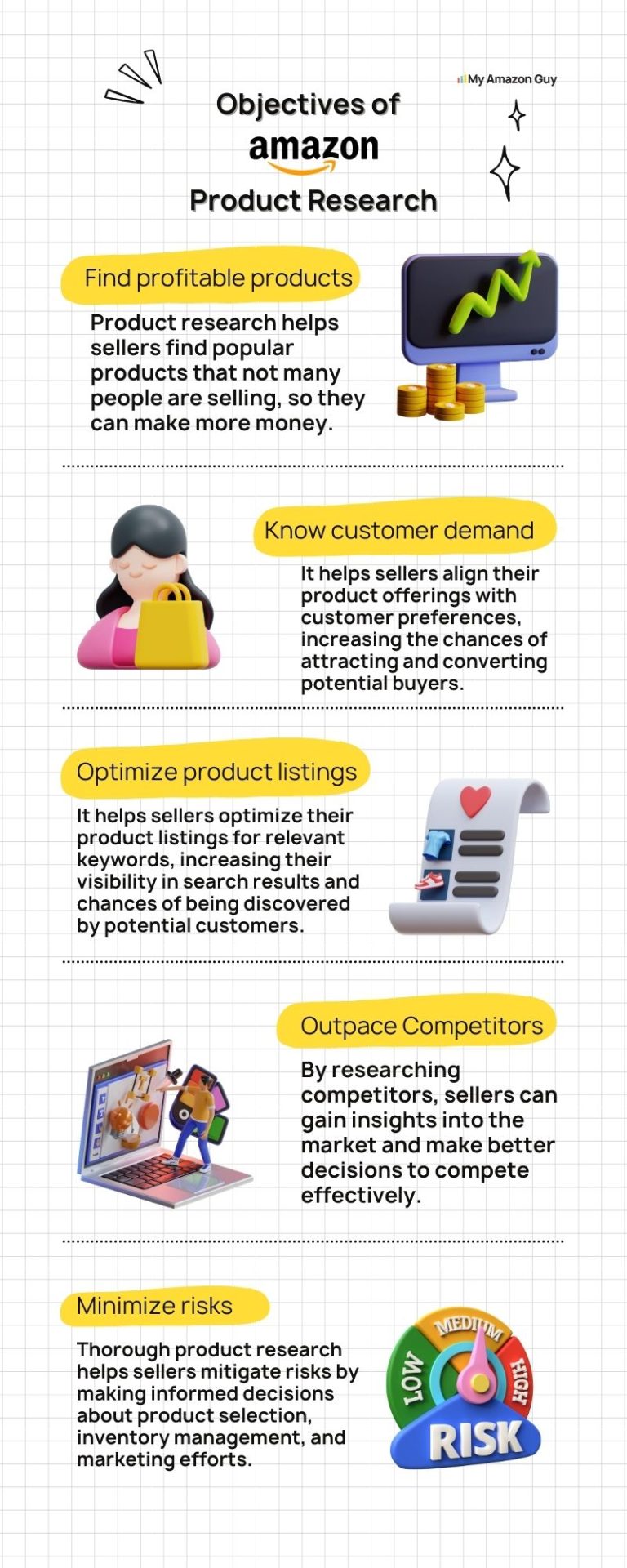
How To Do Amazon Product Research
Watch Steven Pope, founder of My Amazon Guy, as he explains how to conduct product research in this video:
- Define your goals: Start by setting clear goals for your product research. Determine what you want to achieve, such as finding a profitable niche, identifying high-demand products, or expanding your product line.
- Identify product categories: Explore different product categories on Amazon that align with your goals. Look for categories that have a good balance of demand and competition.
- Use Amazon’s Best Sellers and Movers & Shakers: These sections on Amazon provide valuable insights into trending and popular products. Best Sellers show top-selling products in different categories, while Movers & Shakers highlight products that have recently gained significant sales momentum.
- Analyze customer reviews and ratings: Read through customer reviews to understand pain points, product improvements, and features that customers appreciate. This helps in identifying opportunities to differentiate your product or improve upon existing ones.
- Conduct keyword research: Use keyword research tools, such as Amazon’s own search bar autocomplete feature, or third-party tools, to identify relevant keywords that customers use to search for products. This helps in optimizing your product listings and improving visibility.
- Analyze competition: Research and analyze your competitors’ products, pricing, features, and customer reviews. Look for gaps or areas where you can offer a unique value proposition or improve upon existing products.
- Evaluate demand and competition: Use tools like Jungle Scout, Helium 10, or AMZScout to gather data on sales volume, competition levels, and market trends. This data helps in determining the potential demand and profitability of a product.
- Consider sourcing and logistics: Evaluate the feasibility of sourcing the product, including manufacturing costs, shipping, and fulfillment options. This step ensures that you have a clear understanding of the financial aspects and logistics involved in selling the product.
- Validate with a test order or sample: Consider ordering a test batch or obtaining a sample of the product to evaluate its quality and potential market reception. This step helps in making informed decisions before committing to a larger inventory order.
- Make data-driven decisions: Based on your research and analysis, make data-driven decisions about the products you want to sell on Amazon. Consider factors such as demand, competition, profitability, and alignment with your business goals.
Remember that product research is an ongoing process, and it’s important to continuously monitor market trends, customer feedback, and competition to stay ahead in the ever-changing Amazon marketplace.
Amazon Product Research: Product Selection
Trending products
To find trending products to sell on Amazon, there are several strategies you can employ:
- Amazon Best Sellers: Check out the “Best Sellers” section on Amazon’s website. It provides you with a real-time list of the top-selling products in various categories. This can give you insights into popular products and niches.
- Amazon Movers & Shakers: Another helpful section on Amazon is the “Movers & Shakers” category. It showcases the products that have seen the most significant sales growth over the past 24 hours. This can help you identify emerging trends and products that are gaining popularity.
- Product Research Tools: Utilize product research tools such as Jungle Scout, Helium 10, or AMZScout. These tools provide data-driven insights into product demand, competition analysis, and historical sales data. They can help you identify products with high demand and low competition.
- Social Media and Trending Platforms: Keep an eye on social media platforms like Instagram, Facebook, and TikTok, as well as trend-spotting websites like Trend Hunter or Buzzfeed. They can provide you with information on popular products and emerging trends.
- Research Competitors: Analyze your competitors’ product offerings and sales performance. Look for products that consistently sell well for them. However, make sure to differentiate your product and not just copy what others are doing.
- Follow Industry Blogs and Newsletters: Stay up-to-date with industry blogs, newsletters, and forums related to e-commerce and Amazon selling. They often share insights and trends that can help you identify hot products.
Niche products
Niche products can be profitable on Amazon if they have a loyal and passionate customer base. Here are some ways to find profitable niche products:
- Identify your interests and expertise: Start by considering your own interests, hobbies, and areas of expertise. Look for niche markets within those areas that you are knowledgeable about and passionate about. Selling products in a niche that you understand and enjoy can give you an advantage in terms of product selection and marketing.
- Conduct keyword research: Use keyword research tools like Amazon’s search bar autocomplete feature or third-party tools to explore different keywords and phrases related to your interests. Look for long-tail keywords that indicate specific niche markets with lower competition and potentially higher conversion rates.
- Analyze customer reviews and ratings: Read through customer reviews and ratings of products in different categories. Look for recurring pain points or unmet needs that customers express. This can help you identify niche opportunities to address those specific customer demands.
- Explore subcategories and micro-niches: Drill down into subcategories on Amazon to find smaller, specialized niches. By focusing on these micro-niches, you can target a more specific customer base and differentiate yourself from broader competitors.
- Use product research tools: Utilize product research tools like Jungle Scout, Helium 10, or AMZScout to gather data on sales volume, competition levels, and market trends within specific niches. These tools can help you identify profitable niche products by analyzing market demand and competition.
- Monitor trends and emerging markets: Stay updated with industry trends and emerging markets. Keep an eye on social media platforms, industry blogs, news outlets, and relevant forums to identify new niche opportunities that are gaining traction.
Remember, profitability in niche markets often depends on factors such as product quality, unique value proposition, effective marketing, and customer targeting. It’s crucial to validate demand, assess competition, and conduct thorough market research before investing in any niche product.
Learn about some Amazon Product Research Methods in this video:
Seasonal products
These can be profitable on Amazon if you approach them strategically. While they may have a shorter sales window, they can generate significant revenue during peak seasons. Here’s how you can find the best seasonal products to sell:
- Research seasonal trends: Analyze past sales data and trends to identify which products experience a surge in demand during specific seasons or holidays. Look for patterns and identify the products that consistently perform well during those times.
- Explore seasonal categories: Browse through Amazon’s seasonal categories, such as holiday decorations, costumes, gardening supplies, or outdoor equipment. These categories tend to have a higher demand during specific times of the year.
- Use product research tools: Utilize product research tools like Jungle Scout, Helium 10, or AMZScout to identify seasonal products. These tools can provide insights into historical sales data, keyword search volume, and competition levels for specific products and categories.
- Monitor industry trends: Stay updated with industry trends and emerging seasonal products. Follow industry blogs, news outlets, social media platforms, and niche-specific forums to gather insights on popular seasonal items.
- Leverage Amazon’s data: Utilize Amazon’s data to your advantage. Look for products with high customer reviews and ratings during specific seasons. Analyze the sales rank and pricing history of products to gauge their demand and profitability.
- Plan inventory and marketing strategies: When selling seasonal products, it’s crucial to plan your inventory and marketing strategies accordingly. Ensure you have enough stock to meet the demand during the peak season, and create targeted marketing campaigns to attract customers during those specific times.
Remember, while seasonal products can be profitable, it’s important to diversify your product portfolio to ensure a steady stream of revenue throughout the year. Additionally, consider the logistics and storage requirements of seasonal products, as they may have unique challenges compared to non-seasonal items.
Amazon Product Research: Competitor Analysis
Identifying Top Competitors
Analyzing competitor listings
When analyzing competitor listings during product research on Amazon, there are several key elements to look for. Here’s what you should focus on:
- Product title: Analyze your competitors’ product titles. Look for keywords they are using to optimize their listings. Pay attention to the length, clarity, and relevance of the titles. Consider if there are any opportunities to improve upon their approach or differentiate your product.
- Product images: Examine the quality and composition of your competitors’ product images. Look for elements like image resolution, product angles, lifestyle images, and infographics. Consider if there are any gaps you can fill or improvements you can make to highlight the unique features or benefits of your own product.
- Product Description: Read through your competitors’ product descriptions. Look for how they highlight the key features, benefits, and uses of their products. Pay attention to their use of bullet points, formatting, and persuasive language. Identify any areas where you can improve upon their descriptions or provide additional information that sets your product apart.
- Pricing and promotions: Evaluate your competitors’ pricing strategies and any ongoing promotions or discounts they are offering. Consider if their pricing aligns with the value they are providing and if there are any opportunities for you to offer a competitive price or bundle your product with additional value.
- Reviews and ratings: Review the customer reviews and ratings for your competitors’ products. Pay attention to the overall rating, the number of reviews, and the sentiments expressed by customers. Consider if there are any recurring complaints or issues that you can address with your own product or differentiate yourself on.
- Additional content: Look for any additional content or features your competitors are utilizing, such as enhanced brand content or A+ content. Consider if there are any opportunities for you to create compelling content that showcases your product’s unique selling points.
Monitoring competitor pricing
This is an important aspect of Amazon product research. Here are a few ways to effectively track and monitor competitor pricing:
- Manual monitoring: Regularly visit your competitors’ product listings on Amazon and record their prices. This method is time-consuming but can give you a general idea of their pricing strategy.
- Price tracking tools: Utilize price tracking tools like CamelCamelCamel, Keepa, or AMZBase to monitor competitor prices. These tools provide historical price data, price alerts, and price comparison features. You can set up notifications to be alerted when your competitors change their prices.
- Amazon’s “Buy Box” feature: Pay attention to the pricing of products that appear in the “Buy Box.” The “Buy Box” is the default purchasing option on Amazon and is often won by sellers with competitive prices. Monitoring the pricing of products in the “Buy Box” can give you insights into the pricing strategies of your top competitors.
- Competitor analysis tools: Consider using competitor analysis tools like Jungle Scout, Helium 10, or AMZScout. These tools often include features that allow you to track and analyze competitor pricing. They can provide insights into pricing trends, price changes, and competitor behavior.
- Price automation software: If you want to automate the process of adjusting your prices based on competitors, you can use repricing software. Tools like RepricerExpress or SellerApp can help you dynamically adjust your prices to stay competitive.
Amazon Product Research: Profitability
Estimated costs for product sourcing, shipping, and Amazon fees
The estimated costs for product sourcing, shipping, and Amazon fees can vary depending on various factors such as the type of product, size and weight, shipping distance, fulfillment method, and Amazon’s fee structure. While I can provide some general information, it’s important to note that specific costs can only be determined by conducting a thorough analysis of your specific product and business model. Here are some factors to consider:
- Product Sourcing: This includes the cost of manufacturing or purchasing your products. It can vary widely depending on factors such as the complexity of the product, production volume, supplier negotiations, and any additional costs like packaging or customization.
- Shipping Costs: Shipping costs can include both inbound shipping (from the manufacturer or supplier to Amazon’s fulfillment centers) and outbound shipping (from the fulfillment centers to the customer). Factors that can influence shipping costs include the weight and dimensions of the product, shipping method (e.g., air freight, sea freight), distance, and any additional services required (e.g., customs clearance, delivery speed).
- Amazon Fees: Amazon charges various fees for selling on their platform. These fees can include referral fees (a percentage of the product’s sale price), fulfillment fees (if you use Amazon’s FBA service), storage fees (for storing your products in Amazon’s fulfillment centers), and other optional fees like advertising or premium account features. The specific fee structure can vary based on the category and type of product.
Here are some more videos to watch and learn more about profitability:
Break-even on investment
The time it takes to break even on your investment can vary depending on several factors, including the initial investment amount, product costs, selling price, profit margin, sales volume, and expenses such as product sourcing, shipping, and Amazon fees.
To estimate the break-even point, you need to calculate the total costs incurred before reaching the break-even point and compare them with the revenue generated from product sales. Here’s a basic formula to calculate the break-even point:
Break-even point (in units) = Fixed costs / (Selling price per unit – Variable costs per unit)
Fixed costs include expenses that do not vary with the number of units sold, such as product sourcing costs, shipping costs, and any ongoing expenses like storage fees or subscription fees. Variable costs include expenses that vary with the number of units sold, such as Amazon fees, fulfillment fees, and any additional costs associated with each unit sold.
Once you have the break-even point in units, you can estimate the time it will take to reach that point based on your expected sales volume.
Keep in mind that this is a simplified formula, and there may be additional factors to consider, such as marketing expenses, seasonality, and competition. It’s important to conduct a detailed financial analysis and consider different scenarios to get a more accurate estimate of the break-even time for your specific business.
Amazon Product Research: Sourcing
Product sourcing is crucial when conducting Amazon product research for several reasons:
- Quality Control: The quality of the product you source directly impacts customer satisfaction and reviews. By sourcing high-quality products, you can enhance the overall customer experience and build a positive reputation for your brand. Quality control is especially important when selling on a competitive platform like Amazon, where customer reviews play a significant role in product visibility and sales.
- Competitive Pricing: Effective product sourcing allows you to find suppliers that offer competitive pricing. This helps you maintain a competitive advantage by offering attractive prices to consumers while still ensuring profitability. By understanding the market and finding cost-effective sourcing options, you can optimize your pricing strategy and potentially increase your sales and market share.
- Supply Chain Efficiency: Efficient product sourcing ensures a smooth supply chain, from manufacturing or procurement to delivery to Amazon’s fulfillment centers. A well-managed supply chain minimizes delays, reduces the risk of stockouts, and improves order fulfillment. This, in turn, contributes to better customer satisfaction and helps you avoid potential penalties or account suspensions due to inventory issues.
- Profitability: Proper product sourcing is essential for assessing the potential profitability of a product. By accurately estimating your product costs, including sourcing, shipping, and fulfillment fees, you can calculate your margins and determine whether a product is worth pursuing. Understanding the profit potential at the sourcing stage helps you make informed decisions and avoid investing in products that may not yield satisfactory returns.
- Scalability: Sourcing products that are readily available and scalable is crucial for long-term success on Amazon. As your business grows, you’ll need a reliable supply chain that can accommodate increased demand. By establishing strong relationships with suppliers and ensuring a consistent supply of products, you can effectively scale your Amazon business without major disruptions.
Know more about product sourcing by watching these videos:
Reliable product suppliers
To determine if a product supplier is reliable, there are a few key factors to consider:
- Check their reputation and reviews: Look for feedback from other buyers or sellers who have worked with the supplier. This can give you insights into their reliability, product quality, and customer service.
- Evaluate their performance metrics: Consider factors such as their order fulfillment rate, response time, and overall seller rating. This information can be found on e-commerce platforms like Amazon or through third-party tools.
- Verify their certifications and licenses: Depending on the industry and product type, suppliers may need to meet specific standards or hold certifications. Look for any relevant certifications or licenses that ensure their credibility and adherence to quality standards.
- Request samples or conduct product testing: Before committing to a large order, consider requesting samples or conducting product testing to assess the supplier’s product quality and consistency.
- Communication and responsiveness: Prompt and clear communication is crucial when working with a supplier. Ensure they respond to inquiries in a timely manner and are willing to address any concerns or issues that may arise.
- Visit their manufacturing facilities or meet them in person: If feasible, consider visiting the supplier’s manufacturing facilities or meeting them in person. This can provide valuable insights into their operations, production capabilities, and overall professionalism.
Shipping methods
Yes, considering shipping methods is an important aspect when looking for the most profitable product to sell on Amazon. Here are a few reasons why shipping methods should be taken into account:
- Cost of shipping: The shipping costs associated with a product can significantly impact your profitability. It’s essential to consider the weight, dimensions, and fragility of the product to estimate the shipping expenses accurately. Higher shipping costs can eat into your profit margins, so it’s important to choose products that can be shipped at a reasonable cost.
- Shipping speed: Amazon customers have come to expect fast and reliable shipping. Offering expedited shipping options can attract more customers and improve your chances of winning the Buy Box. However, faster shipping methods often come at a higher cost. Balancing shipping speed and cost is crucial to ensure profitability.
- International shipping: If you plan to expand your business globally or source products from overseas, it’s important to consider international shipping methods. Researching and choosing reliable and cost-effective international shipping options can help you reduce expenses and increase profitability.
- Fulfillment method: Amazon offers different fulfillment options like FBA (Fulfillment by Amazon) and FBM (Fulfillment by Merchant). Each method comes with its own advantages and costs. FBA provides benefits like Prime eligibility and customer service, but it also has associated fees. FBM allows for more control over shipping costs, but you’ll need to handle fulfillment yourself. Assessing which fulfillment method aligns with your business goals and profitability is crucial.
By considering shipping methods during product research, you can better evaluate the overall cost structure and estimate potential profitability for the products you plan to sell on Amazon.
Import duties and taxes for my target product
These additional costs can significantly impact your profit margins, so it’s crucial to factor them into your decision-making process. Import duties and taxes vary depending on the country you are importing from and the product category.
You can research the specific duty rates and tax regulations for the products you are interested in selling to get a better understanding of the potential costs involved.
Amazon Product Research: Keyword Research
Identifying high-volume keywords

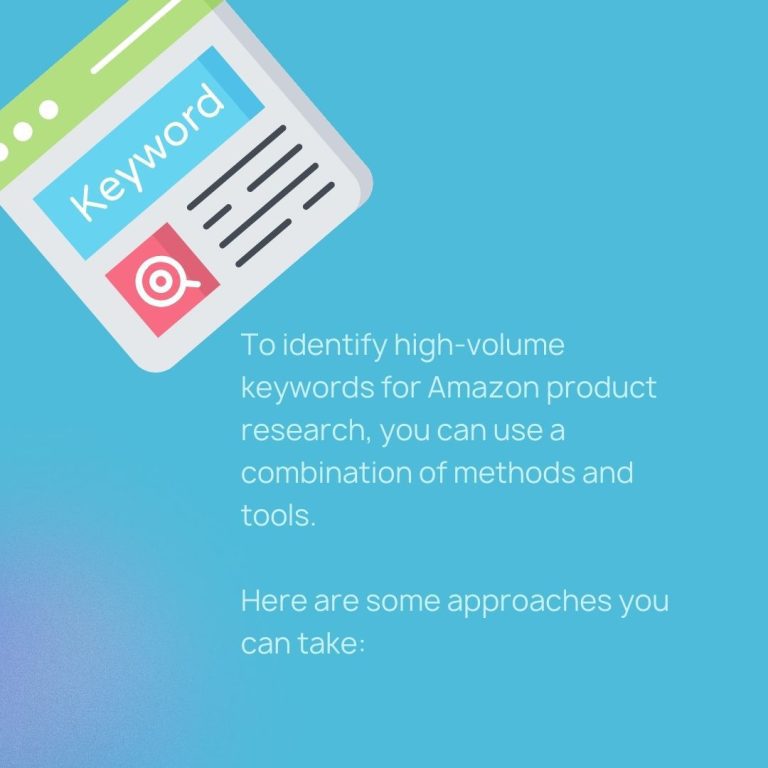
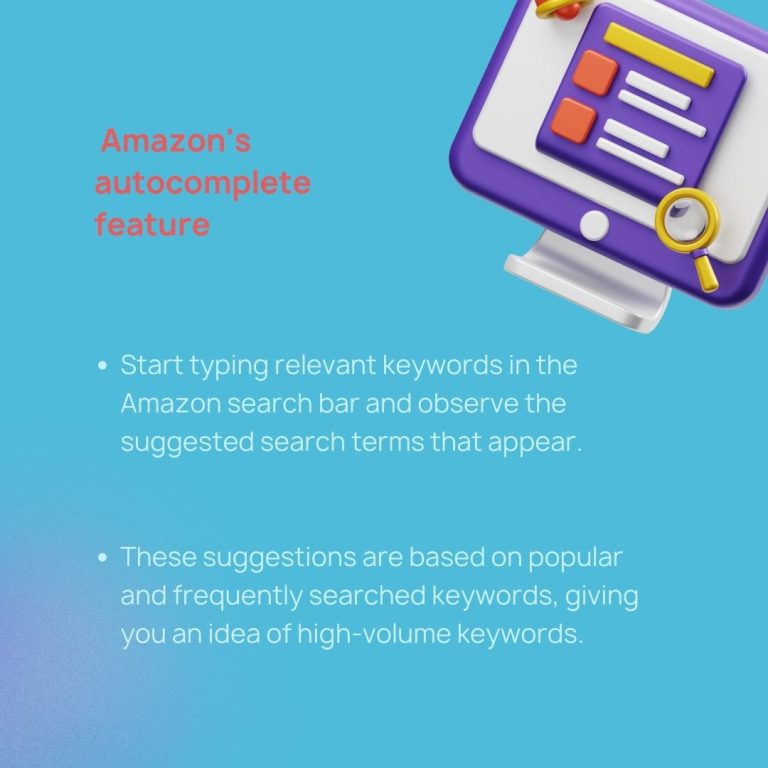
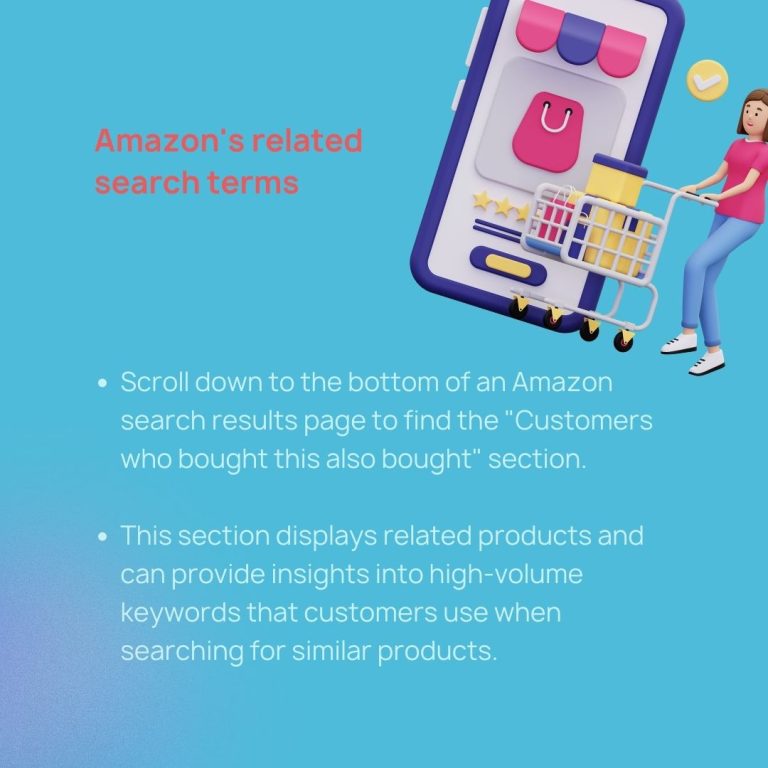
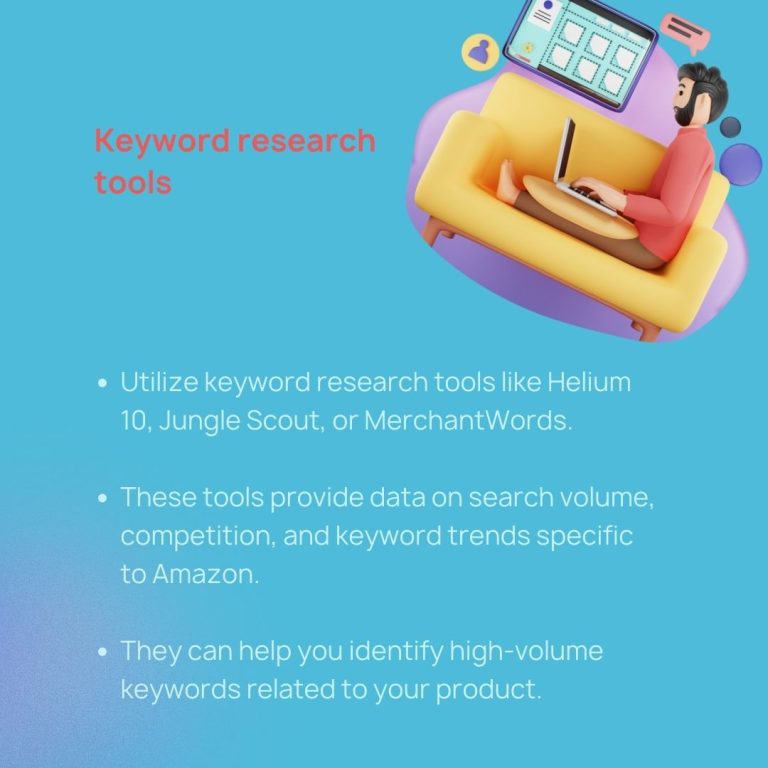
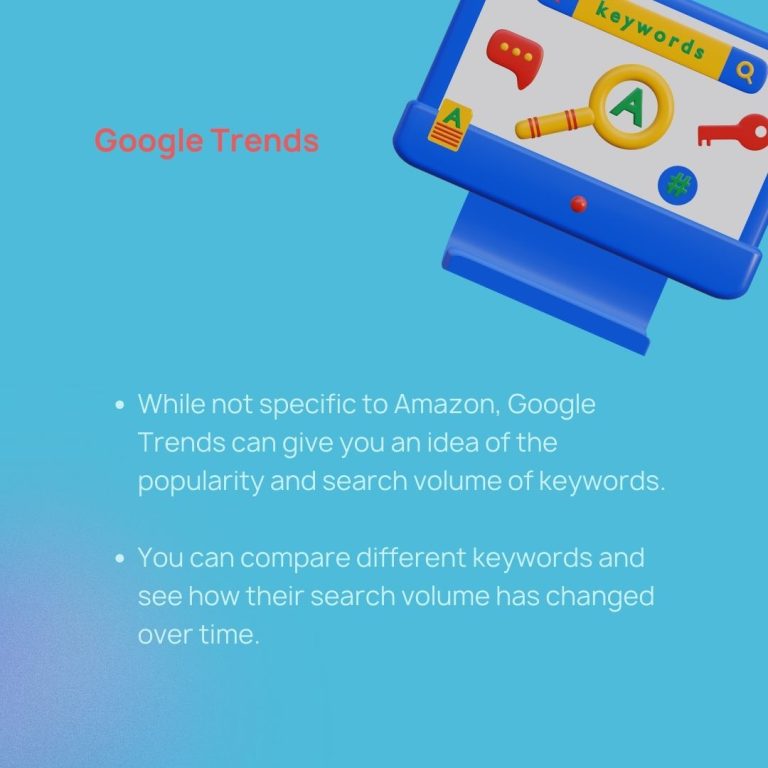

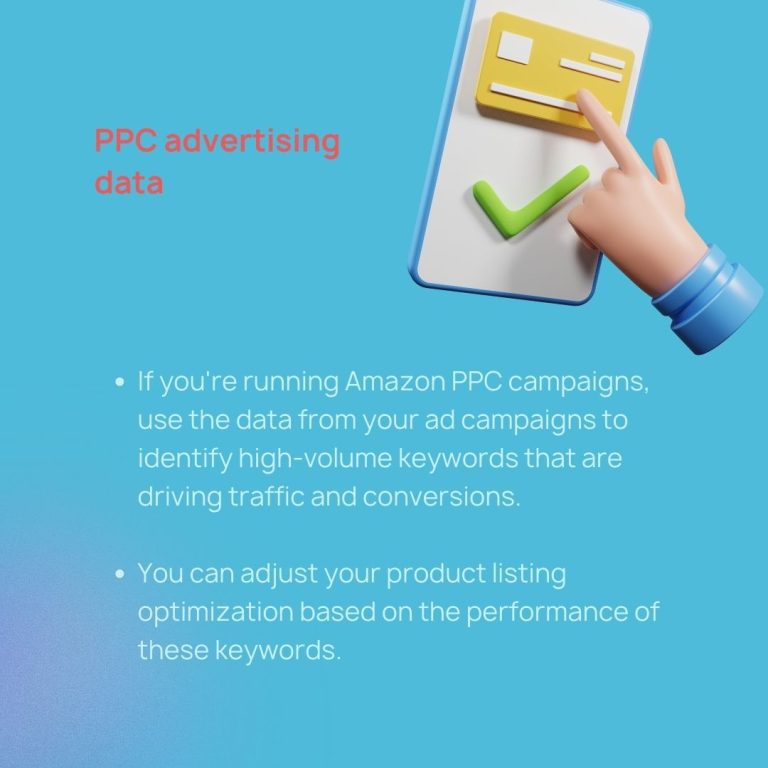
Long-tail keyword analysis
Long-tail keyword analysis is highly important when conducting Amazon product research. Here’s why:
- Targeted traffic: Long-tail keywords are more specific and have lower search volumes compared to broader, generic keywords. However, they tend to generate more targeted traffic because they match the specific intent of potential customers. By optimizing your product listings with relevant long-tail keywords, you can attract highly interested and qualified buyers to your listings.
- Lower competition: Long-tail keywords often have lower competition compared to broader keywords. This means that by targeting long-tail keywords, you can have a better chance of ranking higher in search results and gaining visibility. Focusing on less competitive keywords increases your chances of standing out and attracting customers, especially if you’re in a competitive market.
- Higher conversion rates: Since long-tail keywords are more specific, they tend to attract customers who are closer to making a purchase decision. These customers have a clearer idea of what they’re looking for and are more likely to convert into buyers. By targeting long-tail keywords, you can increase your conversion rates and maximize the return on your Amazon product research efforts.
- Niche targeting: Long-tail keywords often reflect specific niches or subcategories within a broader market. By identifying and targeting long-tail keywords relevant to your niche, you can position your products as specialized solutions, catering to the unique needs and preferences of a specific customer segment. This allows you to differentiate yourself from competitors and build a loyal customer base.
- Voice search optimization: With the rise of voice-activated devices like Amazon Echo and Google Home, long-tail keywords have become even more important. Voice searches tend to be longer and more conversational, mimicking natural language. By incorporating long-tail keywords that match these voice search queries, you can increase your chances of being featured in voice search results and capturing voice search traffic.
Amazon Product Research: Sales Rank Analysis
Understanding Amazon's Best Sellers Rank (BSR)
This is crucial when conducting Amazon product research for several reasons:
- Market demand: BSR provides insights into the popularity and demand for products within specific categories. A lower BSR indicates higher sales volume and indicates that the product is in high demand. By analyzing the BSR of products in your niche, you can identify market trends and determine if there is sufficient demand for your product idea.
- Competitor analysis: BSR allows you to assess the performance of your competitors’ products. By comparing their BSR to yours, you can gauge their sales velocity and overall success. This information helps you evaluate the level of competition and determine if your product has the potential to stand out in the market.
- Product validation: BSR can serve as an indicator of product validation. If a product consistently maintains a low BSR, it suggests that customers are consistently purchasing it, indicating its appeal and market viability. On the other hand, a high BSR may indicate limited demand or strong competition in that product category.
- Pricing strategy: BSR can also provide insights into pricing strategies. By analyzing products with similar BSRs, you can determine the price range in which successful products are priced. This information can help you set a competitive and profitable price for your own product.
- Sales estimation: While BSR alone does not provide exact sales figures, it can be used to estimate sales volume. Various tools and calculators are available that use BSR data to estimate daily or monthly sales for a given product. This information can help you evaluate the sales potential and profitability of a product before investing in sourcing or launching it.
- Product selection: BSR can be used as a filter when selecting products to sell on Amazon. By setting specific BSR thresholds, you can focus on products with a certain level of demand or exclude products with excessively high competition. This can help you identify opportunities and make informed decisions when selecting products for your Amazon business.
Evaluating product demand based on BSR
When evaluating product demand based on BSR while searching for products to sell on Amazon, you can follow these steps:
- Understand BSR categories: Familiarize yourself with the various categories on Amazon and how BSR is calculated within each category. BSR is relative to other products in the same category, so a BSR of 5,000 in one category may indicate a different sales volume than a BSR of 5,000 in another category.
- Look for consistently low BSR: Identify products with consistently low BSR over a period of time. This indicates consistent sales and demand. However, keep in mind that BSR can fluctuate, so look for products that maintain a relatively low rank over time.
- Research BSR ranges: Research the BSR ranges within your target category to understand what is considered a good BSR. This will help you determine if a product’s BSR is indicative of high demand or if it’s underperforming compared to other products in the same category.
- Consider BSR trends: Analyze the historical BSR data of a product to identify trends. Look for consistent improvement or stability in BSR over time, as this indicates sustained demand. Avoid products with volatile or declining BSR trends, as it may indicate inconsistent or diminishing demand.
- Assess the competitiveness of the category: Evaluate the competition within the product category. If the category is highly competitive with many established brands and products, it may be more challenging to gain visibility and sales, even with a low BSR. Consider the level of competition and your ability to differentiate and stand out in the market.
- Validate with other metrics: BSR is just one indicator of product demand. Validate your findings by considering other metrics such as customer reviews, ratings, and sales volume. Positive reviews and high ratings, along with a low BSR, indicate strong demand and customer satisfaction.
- Consider market saturation: Evaluate if the market is saturated with similar products. If there are already numerous sellers offering identical or very similar products with low BSR, it may indicate a saturated market with limited room for new entrants.
For additional BSR resources, here are some videos for you:
Amazon Product Research: Pricing Strategy
Pricing for profit margins
Here are some steps to help you determine the optimal pricing for your products:
- Calculate your costs: Start by calculating the total costs associated with your product, including manufacturing or sourcing costs, shipping fees, packaging costs, Amazon fees (such as referral fees and FBA fees), and any other expenses related to your product. This will give you a baseline for determining the minimum price you need to charge to cover your costs.
- Research competitors’ pricing: Analyze the pricing of similar products in your niche. Look at both high-performing and low-performing competitors to understand the range of prices in the market. Consider the features, quality, and unique selling points of your product compared to your competitors’ products. Price your product competitively based on these factors.
- Determine your value proposition: Assess the unique value proposition of your product. If your product offers additional benefits, higher quality, or unique features compared to competitors, you may be able to justify a higher price point. Consider the perceived value that your product provides to customers and price accordingly.
- Consider desired profit margin: Determine the profit margin you want to achieve with your product. This will depend on various factors such as your business goals, overhead costs, and market conditions. Calculate the desired profit margin as a percentage of your total costs and factor it into your pricing strategy.
- Test different price points: Consider experimenting with different price points to find the optimal balance between maximizing profit margins and maintaining competitiveness. You can run promotions, offer discounts, or adjust prices over time based on customer response and market dynamics. Monitor sales performance and customer feedback to gauge the impact of price changes.
- Monitor market demand and adjust pricing: Continuously monitor the market demand for your product and make adjustments to your pricing strategy as needed. If demand is high and you are consistently selling out, you may consider increasing your prices to maximize profits. Conversely, if demand is low or you are facing excessive competition, you may need to lower your prices to attract customers.
Competitive pricing analysis
This is the process of evaluating and analyzing the pricing strategies of your competitors in order to determine the most effective pricing strategy for your own products. Here are the steps to follow for a competitive pricing analysis:
- Identify your competitors: Start by identifying your direct competitors in the market. Look for products that are similar to yours and target the same customer base. Consider both established brands and emerging competitors.
- Gather pricing data: Collect pricing data for your competitors’ products. This can be done by manually visiting their product listings on Amazon or by using automated tools that track and monitor competitor prices. Take note of the current prices, promotions, and any pricing trends.
- Analyze pricing strategies: Examine the pricing strategies employed by your competitors. Look for patterns and trends in their pricing, such as consistent discounts or price fluctuations. Consider factors like pricing tiers, bundling, or any unique pricing strategies they may be using.
- Compare product features and quality: Evaluate the features, quality, and value proposition of your product compared to your competitors’ products. Determine how your product differentiates itself from the competition and whether this justifies a higher or lower price point.
- Evaluate customer perception: Consider how customers perceive the value of your product compared to your competitors’ products. Look at customer reviews, ratings, and feedback to gauge customer satisfaction and perception. This can help you understand if customers are willing to pay a premium for your product or if you need to adjust your pricing to align with customer expectations.
- Consider your own costs and profit margins: Take into account your own costs, including manufacturing or sourcing costs, shipping fees, packaging costs, and Amazon fees. Calculate your desired profit margin and factor this into your pricing analysis.
- Determine your pricing strategy: Based on your analysis of competitor pricing, product differentiation, customer perception, and your own cost structure, determine the most effective pricing strategy for your product. Decide whether you want to price competitively, offer a premium pricing strategy, or follow a pricing strategy that positions you as the low-cost option.
- Monitor and adjust: Keep a close eye on your competitors’ pricing and market dynamics. Continuously monitor changes in pricing strategies and adjust your own pricing as needed to remain competitive and meet your business goals.
Dynamic pricing strategies
Dynamic pricing is a pricing strategy in which businesses set flexible prices for products or services based on current market demands. This means that the price of a product or service can change over time, depending on factors such as supply and demand, competitor prices, and customer behavior.
Here are some dynamic pricing strategies that you can consider for your Amazon product research:
- Competitive-based pricing: Monitor the prices of your competitors and adjust your prices accordingly. You can set your prices slightly lower to attract customers or match the prices of your top competitors to remain competitive. Automated repricing tools can help you dynamically adjust your prices based on real-time changes in the market.
- Demand-based pricing: Analyze the demand for your product and adjust prices based on the level of demand. If demand is high and you are selling out quickly, you can gradually increase your prices to maximize profitability. Conversely, if demand is low or you have excess inventory, you may need to lower your prices to stimulate sales.
- Time-based pricing: Consider implementing time-based pricing strategies such as flash sales, limited-time offers, or seasonal pricing. These strategies create a sense of urgency and encourage customers to make a purchase. By periodically adjusting your prices based on time-sensitive factors, you can generate increased sales during specific periods.
- Algorithmic pricing: Utilize algorithmic pricing tools that use advanced algorithms to analyze market data and competitor prices. These tools can automatically adjust your prices based on predefined rules and strategies. They take into account factors such as competitor prices, sales velocity, and market demand to optimize your pricing in real-time.
- Bundle pricing: Consider bundling your products together and offering them at a discounted price compared to buying each item individually. This strategy can increase the perceived value for customers and encourage them to purchase more items at once. Bundling can also help you differentiate your product from competitors and increase your average order value.
- Seasonal pricing: Adjust your prices based on seasonal demand and trends. For example, you can raise prices during peak seasons or holidays when demand is high. Conversely, you can lower prices during slower seasons to stimulate sales. Analyze historical sales data and trends to determine the optimal pricing strategy for each season.
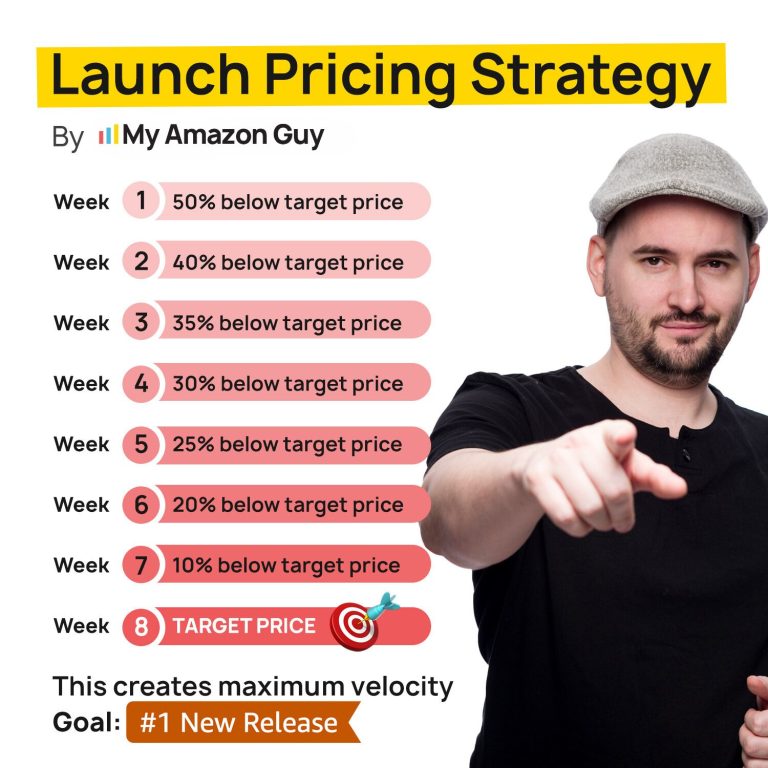
Amazon Product Research: Listing Optimization
Listing optimization plays a crucial role in improving Amazon product research. By optimizing your listing, you can increase your product’s visibility and ranking in search results, ultimately attracting more potential customers.
When conducting product research on Amazon, sellers often analyze various factors such as demand, competition, and profitability. However, even if you find a product with high demand and low competition, it doesn’t guarantee success if your listing is not optimized effectively.
Optimizing your listing involves strategically incorporating relevant keywords in your product title, bullet points, product description, and backend search terms. By doing so, you can improve your product’s visibility when customers search for related keywords.
Moreover, listing optimization helps in creating informative and persuasive content that can help potential customers make informed purchasing decisions. Clear and concise product descriptions, compelling bullet points, and high-quality images can significantly impact customer engagement and conversion rates.
By conducting thorough keyword research and implementing effective listing optimization strategies, you can improve your product’s chances of being discovered by potential customers during their product research process. This, in turn, can lead to higher organic traffic, better conversion rates, and increased sales.
Listing Optimization
To determine if you have optimized your listing effectively to improve Amazon product research, you can consider the following indicators:
- Keyword Ranking: Check the ranking of your listing for relevant keywords. If your listing appears on the first page of search results or in the top positions, it indicates that your optimization efforts are paying off.
- Click-Through Rate (CTR): Monitor the CTR of your listing. A higher CTR suggests that your optimized title, bullet points, and images are effectively attracting potential customers to click on your listing.
- Conversion Rate: Analyze the conversion rate of your listing. If a significant percentage of visitors who view your listing end up making a purchase, it indicates that your optimization efforts have helped create a compelling and persuasive listing.
- Sales Performance: Observe the overall sales performance of your product. If your sales have increased after optimizing your listing, it is a good sign that your optimization efforts are positively impacting your product’s visibility and appeal to customers.
- Customer Feedback: Pay attention to customer reviews and feedback. Positive reviews and satisfied customer experiences can indicate that your optimized listing accurately represents your product and meets customer expectations.
- Competitor Comparison: Compare your listing with those of your competitors. If your listing stands out in terms of its content, presentation, and keyword relevance, it suggests that your optimization efforts have given you a competitive advantage.
Amazon Product Research: Product Reviews
Product reviews can provide valuable insights and help you with Amazon product research in several ways:
- Product Quality and Performance: Reviews can give you an understanding of the quality and performance of a product. Customers often share their experiences, highlighting the pros and cons, durability, functionality, and overall satisfaction with the product. This information can help you assess whether the product meets your expectations and requirements.
- Customer Feedback and Sentiment: Reviews allow you to gauge the sentiment of customers towards a particular product. Positive reviews can indicate customer satisfaction, while negative reviews can highlight potential issues or areas for improvement. By analyzing the feedback, you can identify patterns and common themes to better understand the strengths and weaknesses of the product.
- Competitive Analysis: Reviews not only provide insights into a specific product but also allow you to compare it with similar products in the market. By reading reviews of competing products, you can identify gaps or opportunities, understand customer preferences, and make informed decisions on how to position your own product.
- Feature and Functionality Insights: Customers often share details about specific features, functionality, or use cases in their reviews. This can help you understand how customers are using the product, what features they value the most, and how well the product aligns with their needs. Such insights can guide your product research and help you identify opportunities for improvement or differentiation.
- Social Proof and Trust Building: Positive reviews can serve as social proof, building trust and credibility for a product. Customers are more likely to purchase products with a high number of positive reviews and ratings. By considering the overall sentiment and number of reviews, you can assess the market reception and popularity of a product.
What To Look For In Product Reviews
When conducting Amazon product research, there are several key factors to consider when analyzing product reviews:
- Overall Rating: Look at the overall rating of the product. This provides a quick snapshot of customer satisfaction. Higher ratings generally indicate a well-received product, while lower ratings may suggest potential issues.
- Review Quantity: Consider the number of reviews the product has. A higher number of reviews generally indicates a more established product with a larger customer base. However, keep in mind that newer products may have fewer reviews but can still be worth considering.
- Review Distribution: Analyze the distribution of ratings. Are there a significant number of positive reviews? Are there any common themes or issues mentioned in the negative reviews? Understanding the distribution can give you insights into the overall sentiment and customer experiences.
- Review Content: Dive into the specific content of the reviews. Look for details about the product’s performance, quality, features, and any potential shortcomings. Identifying common themes and patterns in the reviews can help you gauge customer satisfaction and identify areas for improvement.
- Verified Purchase Reviews: Pay attention to reviews marked as “Verified Purchase,” as they come from customers who have actually purchased the product. These reviews tend to carry more weight as they are considered more reliable and credible.
- Recent Reviews: Consider the recency of the reviews. Recent reviews can provide a more accurate representation of the current state of the product, as market conditions and product quality may change over time.
- Reviewer Feedback: Take note of any feedback or comments provided by reviewers. Responding to customer feedback can indicate a brand’s commitment to customer satisfaction and product improvement.
Amazon Product Research: Best Practices
When conducting Amazon product research, there are several best practices to keep in mind:
- Identify a profitable niche: Look for product categories with high demand and low competition. This will increase your chances of success and profitability.
- Analyze product demand: Use tools like Jungle Scout or Helium 10 to assess the sales volume and demand for specific products. Look for consistent and stable demand over time.
- Evaluate competition: Analyze the competition within your chosen niche. Look at factors such as the number of sellers, their reviews, ratings, and product offerings. Consider if you can differentiate your product from existing ones in the market.
- Consider product size and weight: Opt for products that are lightweight and compact as they are easier and cheaper to ship. Large and heavy products can lead to higher shipping costs and storage fees.
- Check for seasonality: Consider if the product you are researching is seasonal or has year-round demand. Seasonal products can be profitable but may require additional planning and inventory management.
- Assess pricing and profit margins: Calculate all costs associated with sourcing, manufacturing, shipping, and selling the product. Ensure that the potential profit margins are sufficient to cover expenses and provide a reasonable return on investment.
- Review product reviews and ratings: Pay attention to customer reviews and ratings for similar products. This will give you insights into potential product improvements or issues to address.
- Stay up-to-date with trends: Keep an eye on emerging trends and changes in consumer behavior. This can help you identify new product opportunities or adjust your existing product offerings.
Amazon Tools That Can Help With Product Research
Here are some of the tools available for use from Amazon:
Marketplace Product Guidance: Advanced Research tool – for evaluating demand and competition for products in international stores
Product Opportunity Explorer – for exploring customer demand for new product ideas
Jason Mastromatteo, VP of Brand Management here at My Amazon Guy, explains in this video how to use the Product Opportunity Explorer.
Amazon Best Sellers – for finding the top-selling products in each category and can be a good starting point for finding products with high demand.
Amazon Suggest – for finding products that are similar to the ones you’re already selling and can be a good way to find new products to add to your inventory.
You can find Amazon Suggest in a few places:
On the product detail page: When you’re viewing a product detail page, you’ll see a section called “Customers who bought this item also bought.” This section will show you products that are frequently purchased together with the product you’re viewing.
In the search results: When you’re searching for a product, you’ll see a section called “Related Products.” This section will show you products that are related to the keyword you’re searching for.
On the home page: On the Amazon home page, you’ll see a section called “Trending Now.” This section will show you products that are currently trending on Amazon.
Conclusion
Amazon product research is a critical step in starting a successful Amazon business. By carefully researching the market, you can find products that are in high demand, have low competition, and are profitable to sell.


